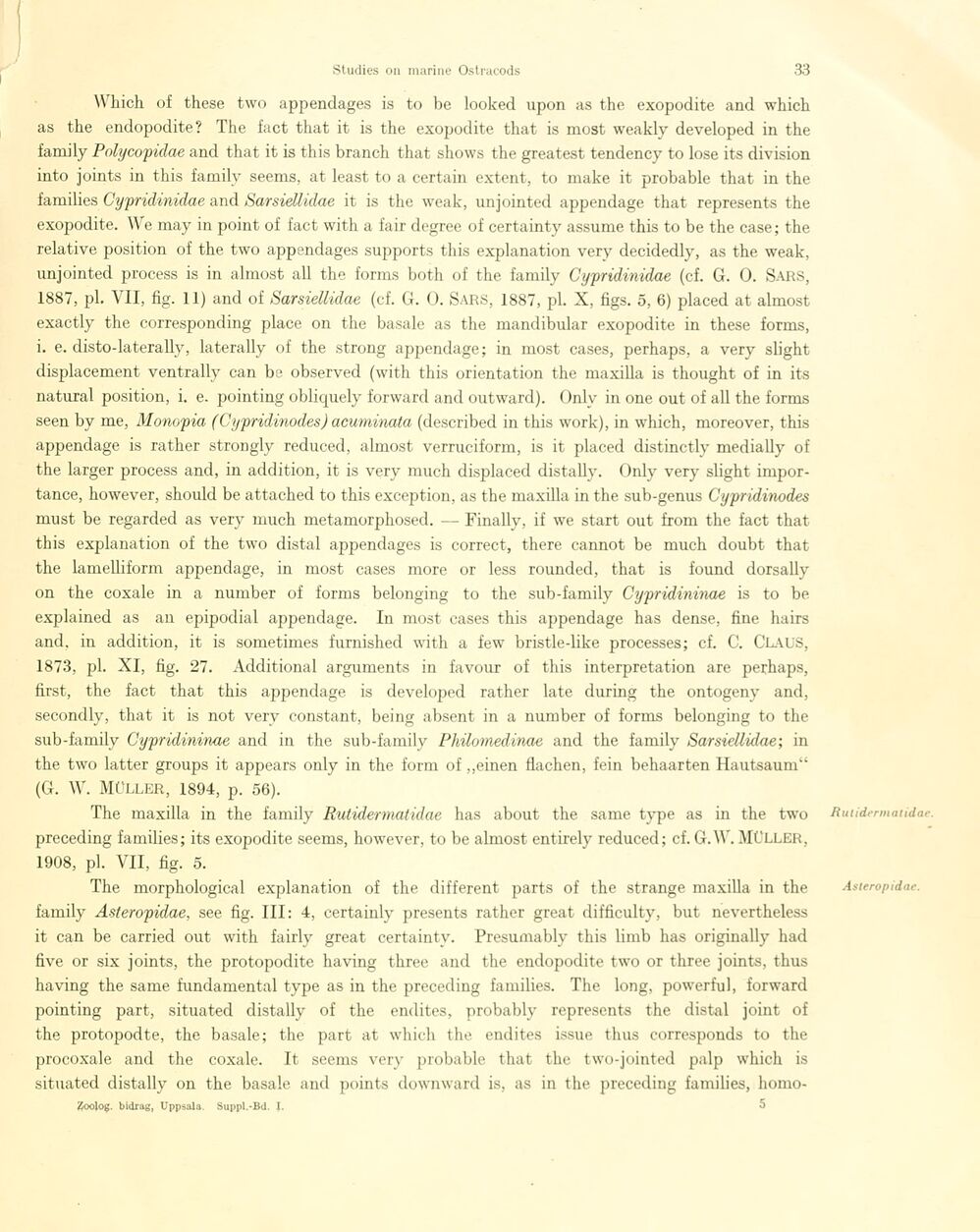
Full resolution (JPEG) - On this page / på denna sida - Sidor ...

<< prev. page << föreg. sida << >> nästa sida >> next page >>
Below is the raw OCR text
from the above scanned image.
Do you see an error? Proofread the page now!
Här nedan syns maskintolkade texten från faksimilbilden ovan.
Ser du något fel? Korrekturläs sidan nu!
This page has never been proofread. / Denna sida har aldrig korrekturlästs.
YYhich of these two appendages is to be looked upon as the exopodite and which
as the endopodite? The faet that it is the exopodite that is most weakly developed in the
family Polycopidae and that it is this brandi that shows the greatest tendency to lose its division
into joints in this family seems, at least to a certain extent, to make it probable that in the
families Cypridinidae and Sarsiellidae it is the weak, unjointed appendage that represents the
exopodite. We may in point of fact with a fair degree of certainty assume this to be the case; the
relative position of the two appendages supports this explanation very decidedly, as the weak,
unjointed process is in almost all the forms both of the family Cypridinidae (cf. G. O. Sars,
1887, pl. A II, fig. 11) and of Sarsiellidae (cf. G. 0. Sars, 1887, pi. X, figs. 5, 6) placed at almost
exactly the corresponding place on the basale as the mandibular exopodite in these forms,
i. e. disto-laterally, laterally of the strong appendage; in most cases, perhaps, a very slight
displacement ventrally can be observed (with this orientation the maxilla is thought of in its
natural position, i. e. pointing obliquely forward and outward). Only in one out of all the forms
seen by me, Monopia (Cypridinodes) acuminata (described in this work), in which, moreover, this
appendage is rather strongly reduced, almost verruciform, is it placed distinctly medially of
the larger process and, in addition, it is very much displaced distally. Only very slight
importance, however, should be attached to this exception, as the maxilla in the sub-genus Cypridinodes
must be regarded as very much metamorphosed. — Finally, if we start out from the fact that
this explanation of the two distal appendages is correct, there cannot be much doubt that
the lamelliform appendage, in most cases more or less rounded, that is found dorsally
on the coxale in a number of forms belonging to the sub-family Cypridininae is to be
explained as an epipodial appendage. In most cases this appendage has dense, fine hairs
and, in addition, it is sometimes furnished with a few bristle-like processes; cf. C. CLAUS,
1873, pl. XI, fig. 27. Additional arguments in favour of this interpretation are perhaps,
first, the fact that this appendage is developed rather late during the ontogeny and,
secondly, that it is not very constant, being absent in a number of forms belonging to the
sub-family Cypridininae and in the sub-family Philornedinae and the family Sarsiellidae; in
the two latter groups it appears only in the form of „einen flachen, fein behaarten Hautsaum“
(G. \V. Müller, 1894, p. 56).
The maxilla in the family Rutidermatidae has about the same type as in the two
preceding families; its exopodite seems, however, to be almost entirely reduced; cf. G.W. MULLER,
1908, pl. VII, fig. 5.
The morphologica! explanation of the different parts of the stränge maxilla in the
family Asteropidae, see fig. III: 4, certainly presents rather great difficulty, but nevertheless
it can be carried out with fairly great certainty. Presumably this limb has originally had
five or six joints, the protopodite having three and the endopodite two or three joints, thus
ha ving the same fundamental type as in the preceding families. The long, powerful, forward
pointing part, situated distally of the endites, probably represents the distal joint of
the protopodte, the basale; the part at which the endites issue thus corresponds to the
procoxale and the coxale. It seems very probable that the two-jointed palp which is
situated distally on the basale and points downward is, as in the preceding families, homo-
Zoolog. bidrag, Uppsala, Suppl.-Bd. I. 5
R u I iderm a I id ae.
Asteropidae.
<< prev. page << föreg. sida << >> nästa sida >> next page >>